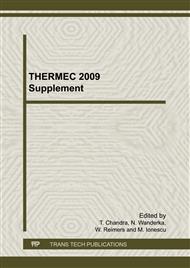p.107
p.112
p.118
p.124
p.130
p.136
p.142
p.147
p.153
Investigations on the Mechanical Behavior of Advanced High Strength Steels Resistance Spot Welds in Cross Tension and Tensile Shear
Abstract:
Advanced High Strength Steels (AHSS) are key materials in the conception of car body structures, permitting to reduce their weight while increasing their behavior in crash conditions. Nevertheless, the weldability of AHSS presents some particular aspects, in that complex failure types involving partial or full interfacial failure can be encountered more often than with conventional mild steels during destructive testing, despite high spot weld strength levels. This paper aims at characterizing the behavior of different AHSS spot welds under two quasi-static loading conditions, tensile shear and cross tension, often used in the automotive industry for the determination of their weldability. Interrupted cross tension and tensile shear tests were performed and spot welds failure was investigated with optical micrographs, SEM fractography and 3D-tomography in order to follow the three-dimensional crack paths due to the complex loading modes. A limited number of failure zones and damage mechanisms could be distinguished for all steel grades investigated. Moreover, numerical simulation of the tests was used to better understand the stress state in the weld and the influence of geometrical features such as weld size on the occurrence of the different failure types.
Info:
Periodical:
Pages:
130-135
Citation:
Online since:
January 2010
Keywords:
Price:
Сopyright:
© 2010 Trans Tech Publications Ltd. All Rights Reserved
Share:
Citation:


